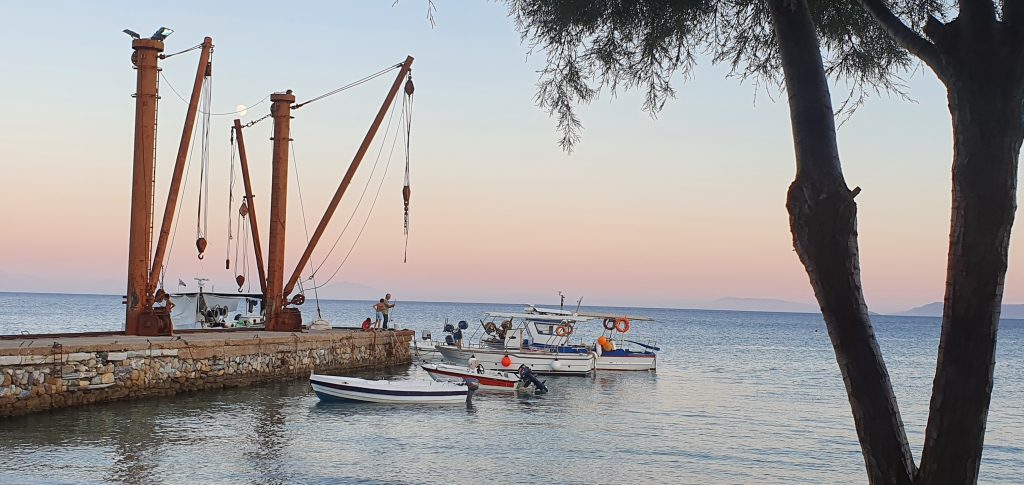Do you really need to rent a car in Naxos?
There are many articles claiming that you can explore Naxos without needing a car, but this is misleading. To truly experience Naxos, you need a car. If you come to Naxos and rely solely on public transportation to visit the tourist spots and villages, you will miss out on the authentic local way of life and the island’s true essence. Simply passing by places, taking pictures, and moving on with a time limit doesn’t allow you to feel the place, understand how life unfolds there, see what the locals do, or engage with their culture and customs. What’s the point of traveling if you only pass by without truly experiencing the destination?
To genuinely appreciate Naxos, a car is essential.
Here’s why — with driving advice from a local islander who has been a traveler herself all her life:
Driving in Greece, and on Naxos, comes with certain unwritten rules that locals know well but might be unfamiliar to tourists. One important custom is that when driving throughout the island, the right of way is often given to locals. As a visitor who is new to the island and unfamiliar with its streets and roads, the best approach is to drive slowly and cautiously. I personally drive no faster than 40, or at most 50 km/h on long roads. Regardless of the circumstances, I adhere to this speed to ensure both my safety and that of others. Driving at this rate allows me to respond safely to any unexpected situations that may arise.
This practice stems from a deep-seated respect for residents who navigate these roads daily and understand their nuances. By driving slowly, you not only ensure your own safety but also show respect for local customs and contribute to a more harmonious driving experience.
As the Greeks say
“Όταν οδηγείς στο χωριό, προτεραιότητα έχει αυτός που είναι από το χωριό” (When driving in the village, priority goes to the one from the village) and
“Καλύτερα να φτάσεις ΑΡΓΑ παρά ποτέ” (Better to arrive LATE than never) and
“Να οδηγείς σιγά να φτάσεις γρήγορα” (Drive slowly to arrive quickly),
Emphasizing the importance of safe and considerate driving.
This unwritten rule applies to all Greek islands and country roads throughout Greece
Advice from Helen: Driving on this self-sufficient island requires a mindful approach, especially as you navigate the crowded tourist beaches and narrow roads. Here, amidst a plethora of trails, you’ll frequently encounter hikers, and bicyclists on blind turns where visibility is limited. Here, in the midst of your journey, encounters with goats, sheep, hedgehogs (particularly at night), donkeys, and wild foxes (known locally as atsides) are common, alongside the ubiquitous presence of cats, a hallmark of Greece. To safeguard these creatures and respect the island’s natural habitat, it’s essential to drive slowly and attentively. Doing so not only ensures your safety and that of others but also preserves the delicate balance of the environment. This conscious approach honors both the local wildlife and the serene charm of the Greek countryside.

WHY IS HAVING A CAR IN NAXOS SO IMPORTANT?
Naxos is the largest island in the Cyclades, boasting a variety of landscapes, from stunning beaches and rugged mountains to charming villages and ancient ruins. Renting a vehicle when visiting Naxos is highly recommended. While many tourist spots are close to Chora, having a vehicle allows you to explore the island’s diverse areas at your own pace. Renting a car or an ATV gives you the freedom to visit more remote and less accessible locations that are not as crowded, providing a more relaxed and comprehensive experience of Naxos. This flexibility ensures you can reach off-the-beaten-path spots that might be inaccessible or inconvenient to reach by public transport, allowing you to fully enjoy all that the island has to offer.
Naxos island spans approximately 430 square kilometers (or 430,000,000 square meters) in total. The stretch from Naxos town (Chora) to the end of Plaka beach, where popular tourist attractions are concentrated, covers a coastal strip of about 10 kilometers (equivalent to 7 miles). Therefore, this area represents approximately 2.3% of Naxos island’s total landmass. By focusing solely on these destinations, visitors experience just a fraction of what Naxos has to offer—leaving the remaining 97.7% of the island waiting to be explored and discovered.
NOTE: All rental car and ATVs agencies on Naxos offer FREE delivery services to the port or airport, allowing you to pick up your vehicle upon arrival and return it at your departure. If you choose to go to your hotel first and then rent a car, most agencies will charge a delivery fee, which varies based on the agency’s policy and the distance from town since most of these agencies’ bases are located in Naxos town or in Aghia Anna or Plaka beach.

Helen’s Advice:
Local Wildlife and Livestock: Be aware of animals that may wander onto the roads, such as goats, sheep, or other wildlife, especially in rural areas. Driving on this self-sufficient island requires a mindful approach, especially as you navigate the narrow country roads. Here, amidst a plethora of trails, you’ll frequently encounter bicyclists on blind turns where visibility is limited. Encounters with goats, sheep, hedgehogs (particularly at night), donkeys, and wild foxes (known locally as atsides) are also common, alongside the ubiquitous presence of cats, a hallmark of Greece.
To safeguard these creatures and respect the island’s natural habitat, it’s essential to drive slowly and attentively. Doing so not only ensures your safety and that of others but also preserves the delicate balance of the environment. This conscious approach honors both the local wildlife and the serene charm of the Greek countryside.
Pedestrians and Cyclists and Families with Strollers: Many island roads are shared with pedestrians, cyclists, and motorcycles especially in tourist areas. Naxos Town and the surrounding beaches are the most crowded spots, with thousands of people walking or cycling, particularly during peak season. Families with kids and strollers also frequent these areas. Unfortunately, most of these roads lack sidewalks, so extra attention is required. It is advisable to drive slowly and with extra precautions, always being alert and giving the right of way to pedestrians and cyclists. Outside of these tourist spots, driving is generally less hectic, except when navigating through villages where the roads are narrow and many cars are parked along the streets.
Driving slowly and giving the right of way to faster drivers is the safest approach. Simply put on your signal, slow down, move to the right, and allow the vehicle behind you to pass.
Navigating Motorcycles and Scooters Safely: Driving in Naxos requires caution, particularly due to the prevalence of motorcycles and scooters, which are favored by many residents, especially the youth. These vehicles frequently intermingle with cars, increasing the risk of accidents. Especially in Naxos Town and around the popular beaches, there is a significant issue with driving and parking due to the high number of cars and motorcycles.
Do I need to rent a vehicle when I visit Naxos or explore through public buses?
Yes, renting a vehicle when visiting Naxos is highly recommended. Naxos is the largest of all the Cycladic islands, and when you arrive, you’ll land either at the port or the airport, both located in Naxos Town (Chora). Chora is the busiest place on the island, not only because it’s the main entry point for visitors, but also because locals come here for shopping, running errands, dealing with governmental issues, and visiting the hospital and other ageancies. Consequently, it gets extremely crowded and hectic at all hours of the day and night.
POPULAR DRIVING ROUTES IN NAXOS: We start with Naxos town Chora➡️ Agios Prokopios➡️Aghia Anna➡️ Plaka Beach ➡️Orkos: these are the most crowded spots on the island and the famous beaches full of restaurants, bars, tavernas, beach bars, rental car agencies, shops.
The road is paved with asphalt up to Agia Anna, but beyond that point, it transitions to gravel. Locals attempt to mitigate dust by wetting the gravel road, yet passing vehicles still generate considerable dust. There is an alternative asphalt route that runs from the town to the airport, continuing above Agia Anna and Plaka. However, this road also turns into gravel in order to reach these points, leading to similar dusty conditions. Currently, there are no sidewalks, necessitating pedestrians to walk alongside passing cars or maneuver strollers along the roadside.
After Orkos beach you can continue driving to reach ➡️Parthena Beach ➡️ Mikri Vigla ➡️ Kastraki ➡️Aliko – Hawai Beach ➡️Pirgaki beach ➡️ Agiasos Beach. To reach these locations, travelers should be aware that certain segments of the road are not asphalt-paved and may be rough or gravelly.
SECLUDED ROADS LESS TRAVELED IN NAXOS: An amazing route is to go from Apeiranthos village down to Moutsouna➡️Panermos. In this route no public buses go. The drive from Moutsouna to Panermos covers 16 kilometers along a picturesque, winding asphalt road that hugs the coastline. As you navigate this smooth route, you’ll be treated to stunning views of the nearby Small Cycladic islands, including Makares, Donousa, Ano Koufonisia, Kato Koufonisia, Amorgos, and Schinousa. Along the way, you’ll encounter numerous secluded beaches with crystal-clear turquoise waters, often with no one else around, offering a serene escape from the crowds. Upon reaching Panermos, you’ll discover one of the calmest beaches on Naxos, sheltered from the wind and consistently tranquil, no matter the weather.

Another fantastic route is the drive from Koronos to Lionas Beach, a pebble-strewn haven renowned for its rugged beauty and tranquility. Accessible only by car, a winding road asphalt till the end, this secluded spot features just two local taverns right by the water, offering an authentic and peaceful escape.

Here’s why:
Exploring Naxos needs a Car
Diverse Landscapes: Naxos is the largest island in the Cyclades, boasting a variety of landscapes, from stunning beaches and rugged mountains to charming villages and ancient ruins. Having a car allows you to explore all these diverse areas at your own pace, offering the freedom to visit off-the-beaten-path locations that might be inaccessible or inconvenient to reach by public transport.
Beaches: Naxos is known for its beautiful and varied beaches, such as Agios Prokopios, Plaka, Mikri Vigla, Pirgaki, Agiasos, Moutsouna, Panermos, Lionas, Apollonas. While some of these beaches are near the main town (Chora) and accessible by bus, many others are more remote. A car makes it easy to explore all the different beaches and enjoy a more secluded experience.
Villages: The island is speckled with charming villages such as Apiranthos, Halki, Koronos, Komiaki, Kinidharos, Moni, Kaloxylos, Damarionas, Potamia, Tsikalario, and Filoti, each boasting rich history, local culture, and traditional architecture. Public transport is limited in these areas, making a car essential for fully exploring and enjoying them. While villages like Chalkio, Filoti, and Apiranthos have regular bus connections to the town throughout the day, adhering to the bus schedule can be time-consuming. These picturesque villages are often highlighted by tour agencies and bus excursions, but there are many more lesser-known gems to discover. Places like Moutsoun, Panermos, and Lionas offer some of the best experiences on Naxos, though they are often overlooked by locals due to their distance from the town.
Historical Sites: Naxos is home to numerous historical and archaeological sites, such as the Temple of Demeter, the Kouros statues, and the Venetian Castle in Chora. A car allows you to create your own itinerary and visit these sites without the constraints of bus schedules.
Hiking and Nature: For hiking enthusiasts, Naxos boasts stunning mountainous terrain that beckons exploration. The island’s trails wind through picturesque landscapes, offering unforgettable vistas and tranquil escapes. Renting a car enhances your adventure by granting access to trailheads nestled in remote areas that might otherwise be challenging to reach.

Choosing Between Automatic and Manual Rental Cars: Considerations for Comfort and Capability
When booking a rental car, choosing between an automatic or a manual transmission requires careful consideration of your driving capabilities and comfort level. If you opt for a manual transmission, ensure that you are proficient in driving one, not just vaguely familiar from past experiences. It’s crucial to select a car that you feel confident maneuvering. If automatic transmission suits you better, specifically request one and avoid settling for a manual to save costs, as manual cars are generally cheaper in places like Greece and Europe where manual driving is more common. Driving an unfamiliar or outdated manual car or selecting it solely for financial reasons can lead to issues, such as damaging the transmission, which is detrimental both to you and the rental company. Additionally, mastering manual driving is essential for navigating narrow, hilly streets where precise clutch and gas pedal coordination is required for smooth operation.

Practical Information-Tips for Renting a Car in Naxos
When to book a rental car:
Booking in Advance: It’s advisable to book your rental car in advance, especially during the peak tourist season (July to September), to ensure availability and secure better rates.
- Driving License: Ensure you have a valid driving license. If you’re from outside the EU, you might need an International Driving Permit (IDP).
- If you’re from outside the EU, you might need an International Driving Permit (IDP).
- In the U.S., you can get an IDP from AAA offices. See instructions here.
Rental car agencies in Naxos: We highly recommend the rental car company listed below
Naxos Auto Rent is known for their excellent service – they offer a diverse range of vehicles at competitive prices. Their friendly and helpful staff, combined with a solid reputation for reliability and safety, make them a top choice. The fleet consists of well-maintained vehicles, and comprehensive insurance coverage provides added peace of mind. Upon your arrival, they will deliver the car to you at the port or airport, and you can conveniently return it upon departure at the port or airport. Mentioning ELaiolithos’ name during the booking process ensures attentive service, although we do not receive any commission. Our primary goal is your satisfaction, and recommending our name helps us achieve that.
How to pick up a rental car: All rental car and ATVs agencies on Naxos offer free delivery services to the port or airport, allowing you to pick up your vehicle upon arrival and return it at your departure. If you choose to go to your hotel first and then rent a car, most agencies will charge a delivery fee, which varies based on the agency’s policy and the distance from town.
How to drop off a rental car: You can drop off at the port or airport. Some also offer pickup directly from your accommodations (they might charge you a fee for that)
PARKING IN NAXOS
Parking in Naxos can be challenging, especially in the main town of Chora, Aghios Prokopios beach, Aghia Anna beach, Plaka beach and during peak seasons. While parking is generally available in most areas during the low season, it becomes extremely limited in popular spots. In Chora, there are both free and paid parking lots. During peak season, from mid-July to the end of August, Naxos Town and the surrounding beaches become extremely crowded. You may find yourself searching for a parking spot for over an hour. We recommend
In most villages on Naxos, cars are not able to enter the interior, so visitors must park along the main road or at designated spots at the entrance or outskirts of each village. Some villages like Chalki, have designated public parking areas, such as near the high school, which can accommodate many cars. Filoti also offers two public parking spots, while in Apeiranthos, parking is typically along the street before entering the village or after.
For other villages, parking is typically found at the village entrance or all along the road, from where visitors can explore the village’s attractions, tavernas, and other highlights on foot.
Local Regulations: When navigating local laws and regulations, be sure to park only in designated areas. Do not leave your car in unauthorized spots, as you risk receiving a ticket. Respect the NATURA protected areas and avoid parking on sand dunes (ammothines) to preserve the natural environment. Remember, nature is for everyone. Respect the environment so locals can enjoy it and it remains beautiful for future generations of tourists.
Customer Misuse: Tourists unfamiliar with the local driving conditions may misuse the vehicles, leading to more frequent accidents or damage.
Please park in designated spots to avoid receiving a 40-euro ticket
ROAD CONDITIONS IN NAXOS:
While the main roads in Naxos are generally in good shape, some can be narrow and winding. So, drive carefully, whether you’re exploring remote areas or famous tourist spots.
In many places, especially around tourist attractions, the famous beaches, towns, and villages, the roads are narrow due to parked cars on one or both sides. Often, only one car can pass at a time. Be prepared to wait for oncoming traffic to clear before proceeding.
Also, some side roads aren’t as well-maintained, which means you might find yourself squeezing past bushes or getting a bit too close to the edge. Just be cautious and avoid sudden maneuvers—you don’t want to end up face-to-face with an oncoming car. And remember, the worst you’ll get is a Greek curse, which is a bit of local color you might not want to experience firsthand!
NAVIGATING NAXOS
Road signs are in both Greek and English, which is handy. To make your drive easier, consider downloading Google Maps offline as a guide. Keep in mind that actual travel times might be longer than estimated because of the winding roads.
Why You Should Use Google Maps Over Apple Maps in Greece and Especially in Naxos
In Greece, everyone uses Google Maps because it is consistently updated and provides more accurate navigation compared to Apple Maps. If you have an iPhone while traveling in Greece, I strongly recommend downloading and using Google Maps instead of relying on Apple Maps. The latter often lacks updates and accuracy, leading to frequent misdirection, dead ends, and narrow streets that appear wide initially but become impassable. To ensure a smoother and more reliable navigation experience, Google Maps is the superior choice.
GAS AND FUEL SUPPLY STATIONS IN NAXOS
Fuel stations are full service, so someone will pump your gas.
They are available in and around Chora, as well as along the roads towards Vivlos, Sagri, Chalkio, Moni, and Filoti. You’ll find numerous gas stations up to Filoti village, but beyond that, the next available station is in Koronida (Komiaki) village. However, if you have a full tank, this distance shouldn’t pose a problem. It’s advisable to fill up your tank upon arriving in Naxos before embarking on longer trips.

Discovering Naxos: A Journey for Tourists and Travelers Alike
A tourist typically seeks out popular attractions and experiences, often following a set itinerary, while a traveler delves deeper into the local culture, exploring off-the-beaten-path locations and engaging more with the community. Naxos, a large and diverse island, offers a perfect blend for both tourists and travelers. To truly experience Naxos, a stay of 4-5 days is ideal, allowing you to uncover its hidden beauty. The island’s mainland and highlands are home to some of its most enchanting sights, including secluded beaches and charming local taverns. Here, you can savor authentic flavors from seasonal, locally-produced ingredients, providing a genuine taste of Naxian life. Whether you’re a tourist or a traveler, Naxos invites you to immerse yourself in its rich culture and stunning landscapes.
Conclusion
Renting a car in Naxos significantly enhances your ability to explore and experience the island to its fullest. Whether you’re interested in relaxing on beautiful beaches, visiting historical sites, or discovering quaint villages, a car provides the flexibility and convenience needed to make the most of your visit to this enchanting Greek island.
When should I use public buses to see Naxos?
Using public buses to see Naxos can be a convenient and cost-effective way to explore the island, especially if you prefer not to rent a car and want to stay just a day or two
Exploring Naxos by bus offers a convenient way to see the island’s highlights, especially if you prefer not to drive. Daily excursions run by bus services take you on six-hour trips, covering key attractions such as the town, Temple of Demeter, Chalkio, Panaghia Drosiani, Filoti, and Apeiranthos before returning to town. Some buses go to Apollonas also. However, buses to other villages operate less frequently, typically leaving in the morning and returning around 2 pm. During the peak season of July and August, destinations like Pirgaki and Mikri Vigla have slightly more frequent bus services.
While taking the bus allows you to explore without the hassle of driving, it does come with time constraints, offering limited time at each stop and predetermined dining spots. In contrast, renting a car gives you the freedom to explore Naxos at your own pace, visit tavernas and restaurants of your choice, interact with locals, and enjoy a more personalized experience. Even if you’re only visiting Naxos for two days, renting a car is highly recommended to maximize your time and see as much of the island as possible.
Using public transportation to explore the island is more budget-friendly but can be time-consuming. To make the most of your visit and see the island’s highlights efficiently, we recommend renting a car.
Here’s what you need to know:
When to Use Public Buses in Naxos
Touristic Spots: Public buses in Naxos have regular schedules that cover most of the popular tourist destinations. They are a great option if you plan to visit well-known spots like Agios Prokopios, Agia Anna, and Plaka Beach. Buses to these beaches run approximately every half an hour from the main town (Chora), making it easy to get to and from these locations without much hassle.
Beach Hopping: If your main interest is spending time at the beautiful beaches, the frequent bus service is quite convenient. You can easily spend the day at Agios Prokopios, then hop on a bus to Agia Anna, and finally end your day at Plaka Beach, enjoying the variety each beach has to offer.
Cost and Convenience: Using the public bus is more economical than renting a car, especially if you’re traveling solo or as a couple. The buses are comfortable and air-conditioned, providing a pleasant travel experience.
Limitations: While buses are great for the main tourist areas, they are less frequent or non-existent for more remote villages and archaeological sites. If you wish to explore the charming inland underrated villages that are not promoted and are off the beaten path or visit historical sites like the Photodotis, or Danakos village, Komiaki village, a car might be necessary as these locations are less accessible by bus.
Timing: Public buses are ideal if you are flexible with your schedule and don’t mind adhering to their timetable. They generally run on time, but it’s always good to check the latest schedule, during peak and off-peak seasons.
Practical Tips
- Bus Schedule: Check the local bus schedule online or at the bus station in Chora for the most up-to-date information.
- Tickets: Purchase tickets at the bus station, on the bus, or at designated kiosks.
- Peak Season: During peak tourist season, buses get very crowded, so try to catch an earlier bus if you want a seat.
Conclusion
Using public buses in Naxos is a great way to explore the island, especially the popular beaches like Agios Prokopios, Agia Anna, and Plaka Beach, with buses departing from Chora approximately every half an hour. For more remote areas, consider renting a car for greater flexibility.
Renting an ATV?
Many people drive ATVs on the island, making them a common sight on the streets every day. Depending on your preferences, you can choose either a car or an ATV. Honestly, a plethora of ATVs navigate the mountainous terrain of Naxos daily without any issues. ELaiolithos is 16 km away from Naxos port, not 20 km as often stated.
While the streets are good, if you want to reach secluded places with gravel roads, renting an ATV is a popular choice. The roads are safe, and since they are island streets, driving slowly ensures you have no problems. As the Greeks say, “Drive slowly to arrive early.”
Additionally, you must wear helmets. Although agencies provide helmets, many people neglect to wear them, which is very dangerous. Driving fast on an ATV is extremely risky, and many accidents occur each year due to speeding and racing around turns, causing the ATVs to lose control and flip. Even if you consider yourself a good driver, know that it is very easy to lose control on turns, and if something unexpected happens while driving fast, ATVs can easily tip over. Therefore, great precautions are necessary!
Deciding between renting a car or an ATV in Naxos depends on your preferences, needs, and the type of experience you’re looking for. Here’s a breakdown of both options to help you make an informed decision:
Renting a Car or Renting an ATV?
By considering these factors, you can choose the option that best suits your travel style and plans for exploring the beautiful island of Naxos.
Helen’s Tip: Remember, the scenic beauty of Naxos is best enjoyed at a leisurely pace—drive carefully, stay aware of your surroundings, and you’ll have a safe and pleasant journey.
Always be prepared for sudden changes in road conditions. By driving slowly, you remain ready for anything and can easily yield to faster vehicles. Use your signal to pull over to the right, stop briefly, let the other vehicle pass, and then resume driving safely.
Enjoy the journey, and drive with care!
~ Helen
Emergency Contact Services: Naxos Telephone Area Code +30 22850
Emergency care is provided free to charge to anyone in public hospitals, regardless of nationality.
The National Emergency Number in Greece is 112, which can be used for any emergency, including medical, police, or fire.
Naxos Police Station: +30 22850 22100 or just dial 100
Naxos Fire Department: +30 2285 032889
Hospital of Naxos: +30 22853 60500
Port Authority: +30 22850 22300
Tourist Police: +30 22850 22100
Taxis (Chora): +30 22850 22444
Bus Service: +30 22850 22291
How do I call an Ambulance in Greece?
DIAL 112 or 166 TO CALL AN AMBULANCE IN GREECE: Emergency medical services are run by the Hellenic National Centre for Emergency Care (EKAB)
Road Assistance (Greek Automobile Club – ELPA): 10400
- For roadside assistance and towing services.
What is 999 in Greece?
Emergency services in Greece.
Calling 999 from a UK mobile in Greece will automatically transfer you to the Greek emergency services.
What is the 911 in Greece?: European SOS 112
This Pan-European emergency number 112 can be called from any telephone (landline, pay phone or mobile cellular phone). Calls are free. It can be used for any life-threatening situation, including: Serious medical problems (such as accident, unconscious person, severe injuries, chest pain, seizure)
Emergency Phone Numbers:
- National Emergency Number: 112.
- Ambulance service phone number: 166.
- Fire Department: 199.
- Forest Fire Authority number: 191.
- Police number: 100.
- SOS Helpline for Abused Women: 15900.
- SOS Doctors: 1016.
- Coast Guard number: 108.
- 1056 – National Child Protection Helpline.
- 116000 – European Hotline for Missing Children.
- 116111 – EU Helpline for Children and Teenagers.







